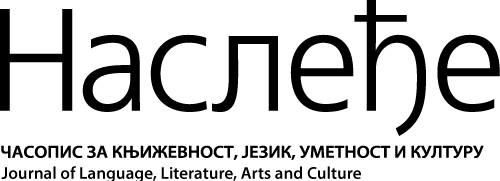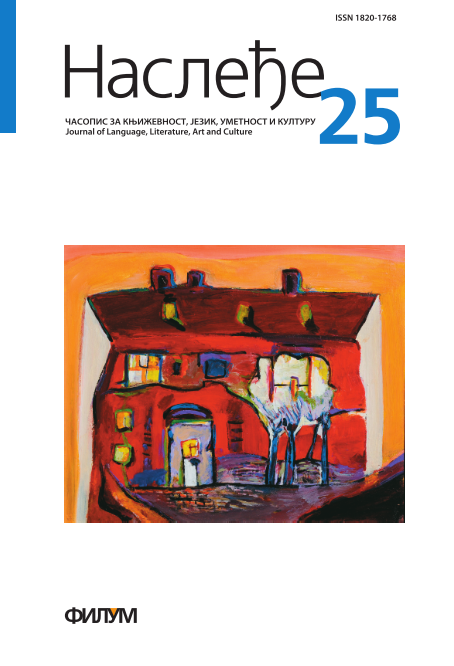THE (IM)POSSIBILITY OF DEFINING ART WITH A SPECIAL FOCUS ON CLUSTER ACCOUNT AND DISJUNCTIVE DEFINITION
Keywords:
essentialism, anti-essentialism, family resemblances, cluster account, disjunctive definition, disjunctive essentialismAbstract
Defining as a method being used to specify theoretical practices of a specific notion, in art philosophy encounters difficulties, and therefore defining the term art, as well as derived concepts such as a work of art, tends to be one of the main problems of aesthetics nowadays. In its first part, this paper represents a description of elementary essential and anti-essential understanding of necessity i.e. inability to define art, while in its second part it deals with the latest cluster account i.e. disjunctive definition of art. Although they tend to use adequacy and logical simplicity to define art as a concept with no clear boundaries and extent, the cluster i.e. disjunctive solutions do not surpass disadvantages of previous attempts of defining. In fact, disjunctive essentialism offers pluralism of solutions based on possible combinations of necessary art conditions represented through disjunctive logical form. Therefore, a great deal of remarks towards essentialistic theories has validity related to this understanding.
References
Bell, Clive, Art, http://www.csulb.edu/~jvancamp/361r13.html, 8.01. 2012.
Beardsley 1983: M. Beardsley: An Aesthetic Definition of Art, у: P. Lamarque and S. H. Olsen: Aesthetic and the Philosophy of Art, Oxford: Blackwell Publishing, 55-62.
Weitz2 2010: M. Weitz: The Role of Theory in Aesthetic, у: P. Lamarque and S. H. Olsen: Aesthetic and the Philosophy of Art, Oxford: Blackwell Publishing, 18.
Витгенштајн 1980: Л. Витгенштајн, Филозофска истраживања, Београд: Нолит.
Волхајм 2002: Р. Волхајм: Уметност и њени предмети, Београд: Клио.
Gaut 2000: B. Gaut, Art as a Cluster Concept у: Noel Carroll: Theories of Art Today, Wisconsin, 25-35.
Грубор, Нeбојша, Витгенштајн и лингвистичка парадигма у филозофији и филозофској естетици, Београд: Архе VI:11, http://www.arhe.rs/ru/arhe-11/vitgenstajn, Децембар 2009. 22.12.2011.
Danto 22010: A. Danto: The Artworld,у:P.Lamarque and S.H. Olsen: Aesthetic and the Philosophyof Art, Oxford: Blackwell Publishing, 27-34.
Davis 2008: S. Davis, The Philosophy of Art, Oxford: Blackwell Publishing.
Dickie 1974: G. Dickie, Art and the Aesthetics, London: Cornell University Press.
Којен 1987: Л. Којен, Столниц и настанак модерне естетике у Џ.Столниц: Две студије о насанку модерне естетике, Нови Сад.
Којен 1989: Леон Којен, Уметност и вредности, Београд: Филип Вишњић.
Kristeller Paul Oskar, The Modern System of Arts: A Study in the History of Aesthetics, JSTOR, Vol. 12:4, 496-527, http://www.jstor.org/discover/10.2307/2707484?uid=3738928&uid=2129&uid=2&uid=70&uid=4&sid=21101737182513 04.01.2012.
Levinson 1979: J. Levinson: Defining Art Historically, British Journal of Aesthetics, Vol 19, 232-50.
Longworth & Scarantino 2010: F. Longworth & A. Scarantino, The Disjunctive Theory of Art: The Cluster Account Reformulated, British Journal of Aesthetics, Vol 50:2, 151-167. http://bjaesthetics.oxfordjournals.org/content/50/2/151, Marth 2010. 10.01.2012.
Lamarque and Olsen 2010: P. Lamarque and S. H. Olsen, Aesthetic and the Philosophy of Art, The Analitic Tradition, Oxford: Blackwell Publishing.
Meskin 2007: A. Meskin, The Cluster Account of Art Reconsidered, British Journal of Aesthetics, 47:4, 388-400, http://philpapers.org/rec/MESTCA,2007. 16.01.2012.






